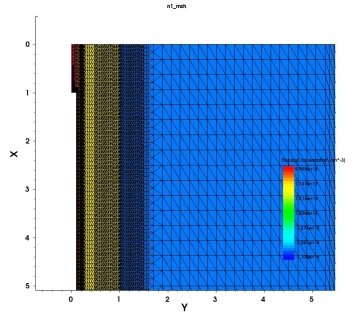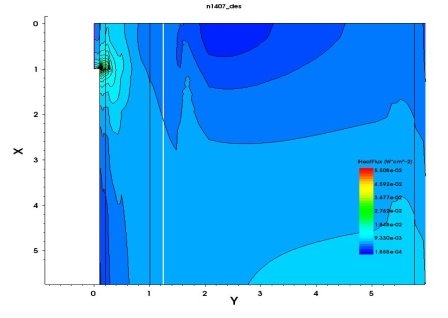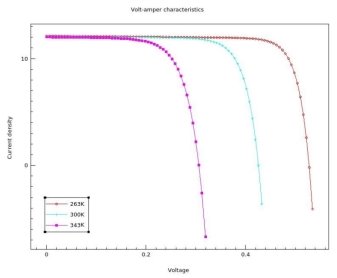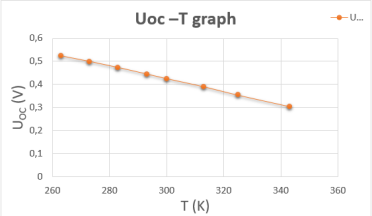In this article, describe model of temperature influence on silicon bases solar cells by Sentaurus TCAD and analyze theoretically.
Key words: Sentaurus TCAD, model, temperature, solar cell, simulation
Nowadays, renewable energy is very important and useful energy type for us. So, scientists who research increasing solar cell efficiency are divided some directions. While one learns the design of the solar cells while others study its internal structure. But all scientists’ purpose is similar. Besides, Using computer technology for describing semiconductors some characteristics increase. We know that theoretical computing is very difficult when we compute large numbers. So we used Sentaurus TCAD simulation to describe the temperature influence on solar cells.
Sentaurus is a suite of TCAD tools which simulates the fabrication, operation and reliability of semiconductor devices. The Sentaurus simulators use physical models to represent the wafer fabrication steps and device operation, thereby allowing the exploration and optimization of new semiconductor devices.
There are some packages and frameworks in Sentaurus TCAD. We used SDE, Sentaurus Device, SVisual packages and Sentaurus Workbench framework for describing the effect of temperature on solar cells.
SDE is 2-D/3-D device editor which builds and edits device structures using geometric operations.
Sentaurus Device is silicon and compound semiconductor device simulator. It simulates the electrical, thermal and optical characteristics of silicon and compound semiconductor devices in 2-D and 3-D. It supports the design and optimization of current and feature semiconductor technologies including nanoscale solar cells and etc.
SVisual is TCAD visualization. It provides users with a state-of-the-art interactive 1-D, 2-D and 3-D visualization and data exploration environment. It supports TCL scripting, enabling the postprocessing of output data to generate new curves and extracted parameters.
Sentaurus Workbench is a complete graphical environment for creating, managing executing and analyzing TCAD simulations. Its intuitive graphical user interface allows users to navigate and automate the typical tasks associated with running TCAD simulations such as managing the information flow, including preprocessing of user input files, parameterizing projects, setting up and executing tool instances and visualizing results with appropriate viewers.
Solar cells are large-area semiconductor devices and have dimensions in the order of centimeters. Simulating the entire three-dimensional (3D) structure involves huge computational resources. However, the structure of the Silicon solar cell is highly symmetric. Therefore, the simulation domain can be reduced to a 2D structure consisting of a cut perpendicular to the front contact metallization grid. The smallest symmetry element spreads out horizontally from the middle of a front contact finger to the midpoint between the two front contact fingers, while vertically, the whole device must be simulated.

Picture 1. Geometrical structure of solar cells which is created by SDE
Sentaurus Device calculates the optical generation rate on variously temperatures in the solar cell and couples it with the electrical simulation. Several methods for computing the optical generation rate are implemented in Sentaurus Device. Besides, we used thermodynamic model for calculating temperature effect on silicon solar cell.
Below we wrote thermodynamic model which is used to simulate temperature effect. With the thermodynamic model, the lattice temperature is computed from [2]:
 (1)
(1)
Where:
κ is the thermal conductivity.
CL is the lattice heat capacity.
EC and EV are the conduction and valence band energies, respectively.
Gopt is the optical generation rate from photons with frequency ω.
Rnet,n and Rnet,p are the electron and hole net recombination rates, respectively.
Jn and Jp are current densities.
Pn and Pp are thermal powers.
![]() and
and ![]() are Fermi potentials.
are Fermi potentials.
We could visualize total heat distribution in silicon solar cell by Sentaurus Visual. Below we show in picture-2.

Picture 2. Distribution of total heat in silicon bases solar cell
We simulated our model on three temperatures. They are t1=-100C, t2=270C and t3=700C. And its simulated by Sdevice and plotted by Sviusal.
We can see difference among IV characteristics of solar cell on three temperatures from graph which is situated above. So, when temperature is increase, efficiency of solar cells is decrease. Mainly, open circuit voltage is decrease. We calculated open circuit voltages in variously temperatures and created graph of temperature dependence open circuit voltage (Picture-4).
Because, when temperature is increase, intrinsic carrier concentration is increase very fast. We can see below [1]:
 (2)
(2)

Picture 3. Graph of IV characteristics on variously temperatures

Picture 4. Graph of temperature dependence open circuit voltage
We know that p-n junction solar cell reversal current is proportional to intrinsic carrier concentration. Below, we wrote I-V characteristics equation of solar cells [2].
 (3)
(3)
If we want to fabricate solar cells which will be constantly efficiency, we investigate new generation solar cells that temperature will not depend strongly on intrinsic carrier concentration of these.
References:
- K. Kells, General Electrothermal Semiconductor Device Simulation, Series in Microelectronics, vol. 37, Konstanz, Germany: Hartung-Gorre, 1994.
- D. Chen et al., “Dual Energy Transport Model with Coupled Lattice and Carrier Temperatures,” in Simulation of Semiconductor Devices and Processes (SISDEP), vol. 5, Vienna, Austria, pp. 157–160, September 1993.







